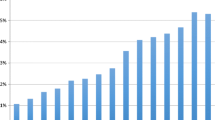Abstract
I analyze implicit transaction costs of trading government debt securities on the Spanish stock exchanges (SE) electronic trading system. The SE’s multilateral system is used mainly as an outlet for retail investors to liquidate Treasury accounts positions before maturity. I compare identical Treasury security trades on the same day in two different markets: the SE and the interdealer market. By analyzing these yield spreads I learn more about the behavior of the markdowns included in the retail prices from the institutional prices. I find evidence that these yield premia depend on traditional features to explain wholesale market liquidity premia.

Similar content being viewed by others
Notes
Both the opening and the maintenance of a direct account at the Bank of Spain are free of charge. Only if there is a payment of either interests or principal, the Bank of Spain applies a commission of 0.15% of the transferred amount with a minimum of €0.90. Fernández et al. (2007) analyze the investment in Spanish mutual funds for the period 1997–2006. They observe that the Total Expense Ratio (i.e., explicit fees and commissions divided by the fund’s total assets) is 0.74% for short-term fixed-income mutual funds, and 1.20% for long-term fixed-income mutual funds. This ratio does not include fees that managers pay for trading assets.
However, if a stock broker receives a limit order, i.e. an order with price, he does not have any duty to buy the assets. If the order has not been executed by the end of the month in which he is responsible to place the order, he transfers the order back to the Bank of Spain.
Also, BIS (2001) analyzes the advantages of electronic trading platforms for reducing liquidity risk premia. However, most or even all of these advantages are unsuitable in a market as illiquid as the electronic trading system of the SE.
Additionally, a summary of transaction prices, yields, and volumes per traded government security is published daily in the bulletin of both the MDPA and the SE market. There is an electronic version of each bulletin available for free on the Internet.
A component of the yield spreads can result from the different timing of the transaction during the day.
I exclude extreme observations (approximately 2% of matched pairs). These figures are similar for bills. They are not reported to conserve space and are available on request.
References
Bank for International Settlements (2001) The implications of electronic trading in financial markets. Committee on the Global Financial System, January
Bessembinder H, Maxwell W, Venkataraman K (2006) Optimal market transparency: Evidence from the initiation of trade reporting in corporate bonds. J Financ Econ 82:251–288. doi:10.1016/j.jfineco.2005.10.002
Biais B, Declerck F (2007) Liquidity, competition & price discovery in the European corporate bond market. IDEI Working Papers, no. 475
Díaz A, Merrick J, Navarro E (2006) Spanish Treasury Bond Market Liquidity and Volatility Pre- and Post-European Monetary Union. J Bank Finance 30(4):1309–1332. doi:10.1016/j.jbankfin.2005.05.009
Edwards AK, Harris LE, Piwowar MS (2007) Corporate Bond Market Transaction Costs and Transparency. J Finance 62(3):1421–1451. doi:10.1111/j.1540-6261.2007.01240.x
Fernández P, Carabias JM, De Miguel L (2007) Mutual funds in Spain (Rentabilidad de los Fondos de Inversion en 1991–2006), SSRN Working Paper
Fisher L (1959) Determinants of risk premiums of corporate bonds. J Polit Econ 67(3):217–237. doi:10.1086/258172
Fleming MJ (2002) Are larger Treasury issues more liquid? Evidence from bill reopenings. J Money, Credit Bank 3(2):707–735. doi:10.1353/mcb.2002.0013
Glaessner TG, Kantur Z (2004) Two case studies on electronic distribution of Government securities: The U.S. treasurydirect system and the Philippine expanded small investors program. World Bank Policy Research Working Paper no. 3372
Goldstein M, Hotchkiss E, Sirri E (2007) Transparency and Liquidity: A Controlled Experiment on Corporate Bonds. Rev Financ Stud 20:235–273. doi:10.1093/rfs/hhl020
Gravelle T (1999) Liquidity of the Government of Canada securities market: Stylized facts and some market microstructure comparisons to the United States treasury market. Bank of Canada Working Paper no. 99–11
Green RC, Hollifield B, Schürhoff N (2007) Financial Intermediation and the Costs of Trading in an Opaque Market. Rev Financ Stud 20:275–314. doi:10.1093/rfs/hhl012
Harris L, Piwowar M (2006) Secondary trading costs in the municipal bond market. J Finance 61:1361–1397. doi:10.1111/j.1540-6261.2006.00875.x
Hong G, Warga A (2000) An empirical study of bond market transactions. Financ Anal J 56(2):32–46. doi:10.2469/faj.v56.n2.2342
Jordan SD, Kuipers DR (2005) End-of-day pricing in the U.S. Treasury market: a comparison of GovPX and the Federal Reserve Bank of New York. J Financ Res 28(1):97–113. doi:10.1111/j.1475-6803.2005.00116.x
Kahn N (2007) Impact of electronic trading platforms on the brokered interdealer market for Government of Canada benchmark bonds. Bank of Canada working paper 2007-5
O’Hara M (1995) Market Microstructure Theory. Blackwell Publishers Inc., Cambridge, MA
Sarig O, Warga A (1989) Bond price data and bond market liquidity. J Financ Quant Anal 24(3):367–378. doi:10.2307/2330817
Schultz P (2001) Corporate bond trading costs: a peek behind the curtain. J Finance 56(2):677–698. doi:10.1111/0022-1082.00341
Warga A (1991) Corporate bond price discrepancies in the dealer and exchange markets. J Fixed Income 1:7–16
Warga A (1992) Bond returns, liquidity, and missing data. J Financ Quant Anal 27(4):605–617. doi:10.2307/2331143
Acknowledgements
I would like to express my gratitude to Paul Kupiec (the editor), an anonymous referee, and Eliseo Navarro, Alberto Cillán, Fermín Ederra, John Merrick, Manuel Montes, Gregorio Oyaga, and Frank Skinner for their helpful comments and suggestions, and to Bolsa de Madrid for providing part of the information used in this research. I also acknowledge the financial support provided by Junta de Comunidades de Castilla-La Mancha grant PCI08-0089 and Ministerio de Educación y Ciencia grant SEJ2005-08931-C02-01, which are partially supported by FEDER funds. Any error is entirely my own.
Author information
Authors and Affiliations
Corresponding author
Rights and permissions
About this article
Cite this article
Díaz, A. Retail Investors and the Trading of Treasury Securities. J Financ Serv Res 36, 45–63 (2009). https://doi.org/10.1007/s10693-009-0062-y
Received:
Revised:
Accepted:
Published:
Issue Date:
DOI: https://doi.org/10.1007/s10693-009-0062-y




